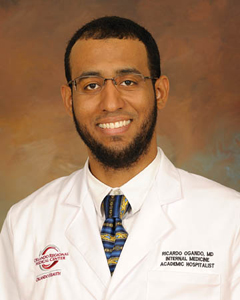The Worst Types of Wounds
As a wound care physician at South Seminole Hospital, I treat all kinds of patients who need different types of care. Wounds, which occur due to pressure injury, infection, a cut or direct impact, come in all shapes, sizes and levels of severity. We’ve treated surgical wounds and traumatic wounds caused by a fall or contusion which lead to a large hematoma (when blood collects outside the blood vessels and leaks into the tissues. Other group of severe wounds are those caused by an inflammatory process in patients with autoimmune diseases like lupus and rheumatoid arthritis. However, the most severe wounds we treat often involve infected ischemic diabetic foot ulcers and stage 4 pressure ulcers, which are also called bedsores. They are the hardest to treat and the ones that also bring the biggest consequences and complications to patients.
Care and Treatment for Diabetic & Pressure Ulcers
Stage 4 pressure ulcers can happen on almost any area of the body. When these ulcers reach this stage, the area has lost all the different layers of soft tissues of the skin and either bone or muscle is exposed. On the pelvis or buttocks area, you could have a wound that’s so deep you see the spinal bone. Typically, these wounds are very challenging to treat because for a patient to get to that point it’s a gradual process where there's been loss of function or poor nutrition. Often these are patients are seriously ill, which presents another challenge. A diabetic ulcer could be rapid, but stage 4 pressure ulcers develop more gradually.
In some cases when patients with these wounds come to see us, they will either have clear signs of bad circulation to the point where they need it fixed immediately, or gross signs of infection or gangrene. Treatment has to be quick. Normally at this point, the patient is admitted to the hospital, and from there we involve the vascular department to open up the patient’s circulation. At the same time, a patient will receive IV antibiotics. After this, we perform an extensive removal of all the dead and infected tissues, and then the long-term recovery process begins with everything we have at our disposal to enhance the patient’s healing.
Can You Prevent These Ulcers?
In many cases, prevention is the best form of medicine, but this may not always be possible when someone is really ill. Better diabetes management can reduce the risk of diabetic ulcers. If you have diabetes, follow the diet your doctor recommends and take your prescribed medications to keep your numbers at goal or as close to goal as possible. It’s also important to make sure there aren’t any lesions that may precede an ulcer, like a callous. A callous is usually a sign of pressure that eventually can develop into a wound, which can lead to complications.
Also watch out for symptoms like muscle pain in the lower part of the legs when you walk, cramps at night and hair loss. Losing hair on your lower extremities indicates your circulation may be deteriorating. When you see this, schedule an appointment with your doctor and get evaluated as soon as possible before you develop a wound or experience more serious complications.
With bedsores, it’s important to frequently reposition and turn patients, and make sure they’re very clean on a regular basis and have good nutrition and good hydration. The problem with these wounds usually is that the patient may not be aware of what's going on or can’t participate in his or her own care, so creating a good prevention plan is a lot more difficult. It’s also difficult to create a good prevention plan for seniors who may live by themselves or be alone during the day when their caregivers go to work, so in many cases these types of ulcers may be unavoidable or inevitable.
Whether it’s a diabetic or pressure ulcer, early intervention is key. The worst thing you can do is ignore it, especially if you already have a medical history of other health issues. We often have a tendency to see something and think "Oh, it will get better" or “Is this really worth a trip to the doctor?” but that's always the worst thing to do. That's how most of these wounds turn into a bigger problem.
Either reach out to your primary care doctor or to a wound center when you find a wound — no matter how small it might be. Things can go bad really quickly, especially if you have diabetes or already have been to the ER or urgent care several times for this issue. See your doctor as soon as possible. Even if your wound isn’t serious, a little precaution never hurt anyone.
Visit this page for more information on the Orlando Health Wound Healing Center.
Are you interested in learning more about our Wound Healing Center?
The Wound Healing Center is a state-of-the-art outpatient facility, staffed by a multidisciplinary and experienced team of physicians, nurses, therapists and technologists, specializing in treating and healing all open wounds.
Learn More Here


